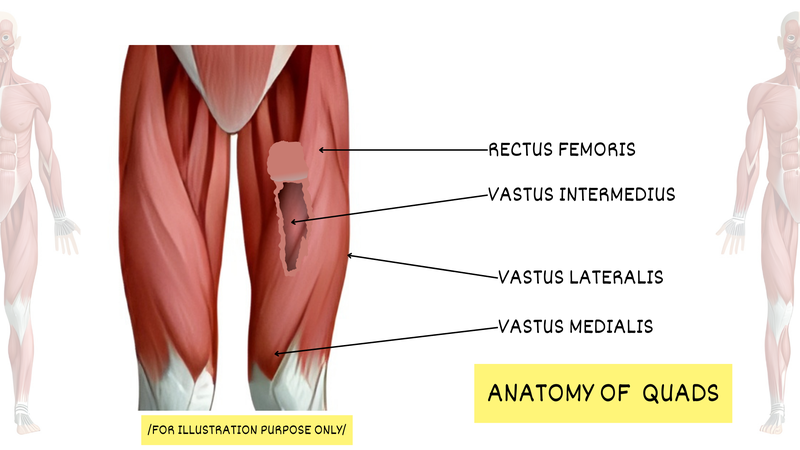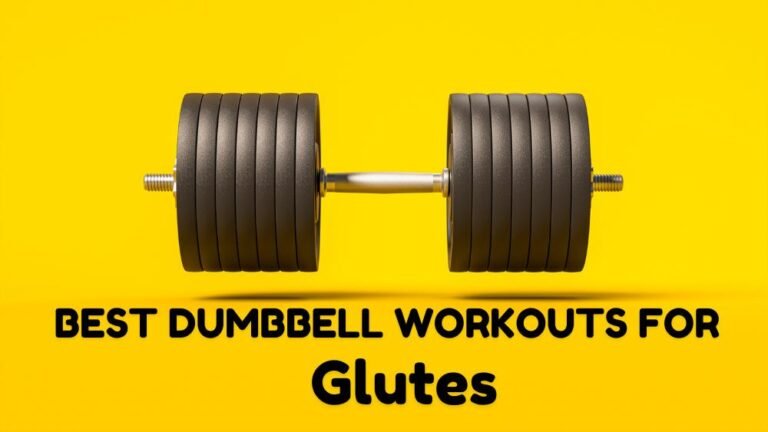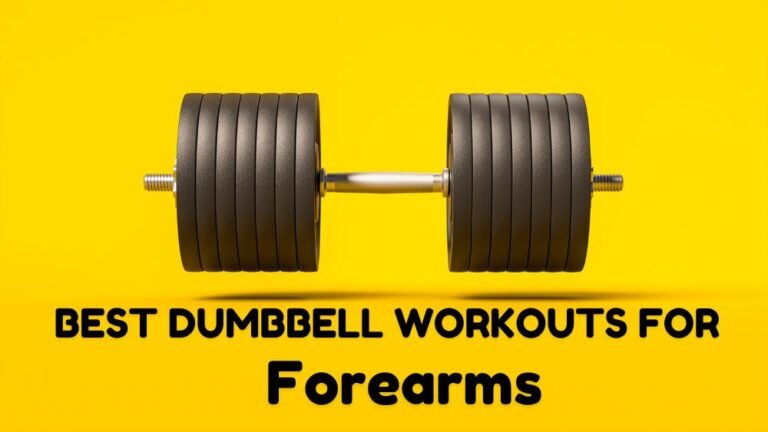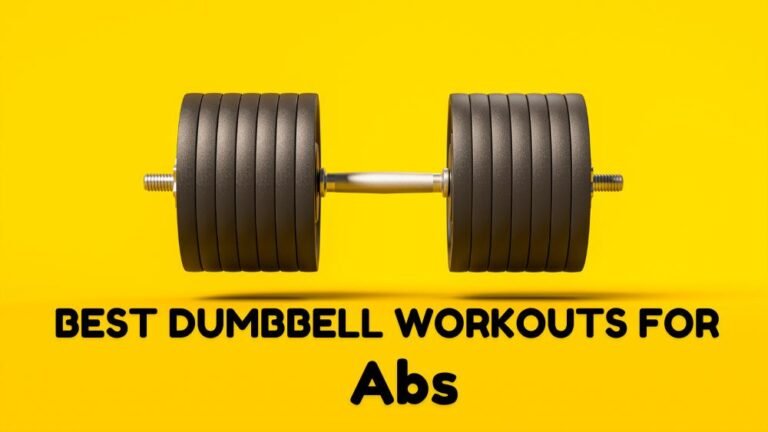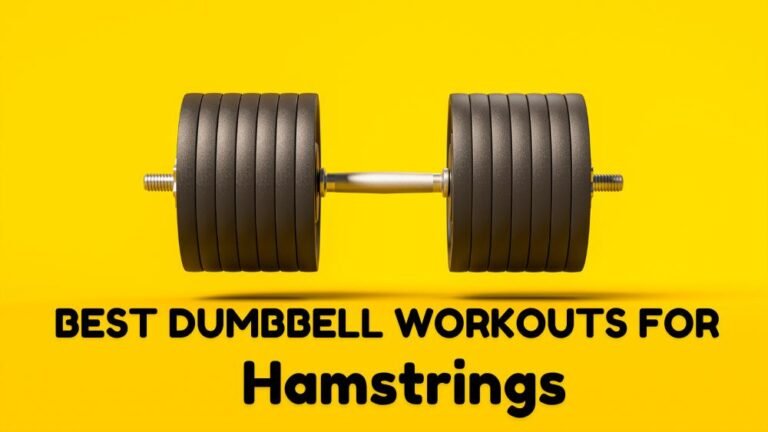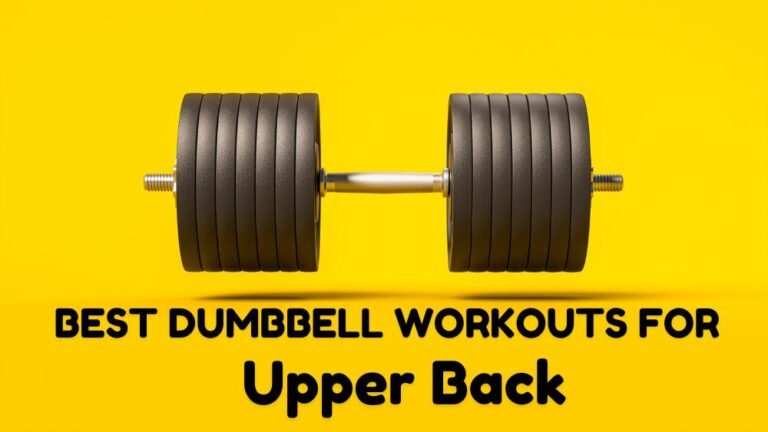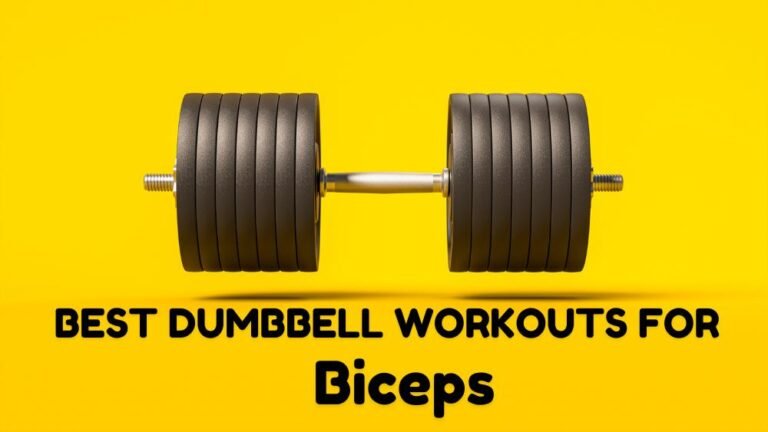10 Best Dumbbell Exercises to Sculpt Your Quads
When it comes to building strength and definition in the quadriceps, incorporating dumbbell exercises into your fitness routine can be a game-changer.
Quads play an important role in various movements, from walking and running to jumping and squatting, making them essential for overall lower body strength and athletic performance.
Whether you’re a seasoned athlete or a beginner looking to enhance your leg workouts, understanding the benefits of targeted exercises is key to achieving your fitness goals.
In this article, we’ll explore effective dumbbell exercises specifically designed to engage and strengthen your quads, helping you maximize your workouts and improve your lower body functionality.
Best Quads exercises with dumbbell
When targeting the quadriceps with dumbbells, it’s crucial to focus on movements that emphasize knee extension and hip flexion.
Incorporating a variety of stances and angles can enhance muscle activation and promote strength gains.
It’s advantageous to include both unilateral and bilateral exercises to guarantee balanced development and improve overall stability.
Additionally, adjusting the tempo and incorporating pauses can further challenge the muscles, leading to greater hypertrophy and endurance.
Remember to prioritize proper form and alignment to prevent injury while maximizing effectiveness.
Dumbbell Squat
The Dumbbell Squat is an excellent exercise for targeting the quadriceps, glutes, and hamstrings. By incorporating dumbbells, you can enhance the intensity of the squat while also improving your balance and stability. This compound movement not only builds strength in the lower body but also engages the core, making it an effective full-body workout.
Whether you’re looking to increase muscle mass or improve your overall strength, the dumbbell squat can be easily adjusted to suit your fitness level by varying the weight and number of repetitions.
To execute the Dumbbell Squat correctly, follow these steps:
- Stand with your feet shoulder-width apart, holding a dumbbell in each hand at your sides or at shoulder level.
- Engage your core, keeping your chest up and back straight.
- Slowly lower your body by bending at the hips and knees, ensuring your knees stay aligned with your toes.
- Continue descending until your thighs are parallel to the ground or as low as your flexibility allows.
Dumbbell Front Squat
The Dumbbell Front Squat is an effective exercise that primarily targets the quadriceps while also engaging the core and improving overall stability.
This variation of the traditional squat allows for a greater range of motion and focuses on maintaining an upright torso, which places more emphasis on the quads compared to other squat variations. It’s an excellent choice for those looking to build strength, enhance muscle definition, and improve functional fitness.
To execute the Dumbbell Front Squat correctly, follow these steps:
- Start by standing with your feet shoulder-width apart, holding a dumbbell in each hand at shoulder height with your palms facing you.
- Engage your core and keep your chest up while maintaining a neutral spine.
- Slowly lower your body into a squat by bending your knees and pushing your hips back, ensuring your knees track over your toes.
- Descend until your thighs are parallel to the ground or lower if your mobility allows.
Dumbbell Lunges
Dumbbell lunges are an effective exercise for targeting the quadriceps while also engaging the hamstrings, glutes, and core muscles. This compound movement not only helps to build strength and size in the quads but also improves balance and coordination.
By incorporating dumbbells, you increase the resistance, allowing for greater muscle activation and a more challenging workout. Whether performed as part of a leg day routine or included in a full-body workout, dumbbell lunges can lead to significant improvements in lower body strength and overall fitness.
To execute a dumbbell lunge properly, follow these steps:
- Stand upright with a dumbbell in each hand, arms resting at your sides.
- Step forward with one leg, lowering your body until both knees are bent at approximately 90 degrees.
- Confirm your front knee is directly above your ankle, while your back knee hovers just above the ground.
- Push through the heel of your front foot to return to the starting position.
Dumbbell Step-Up
The Dumbbell Step-Up is an effective exercise for targeting the quadriceps while also engaging the glutes and hamstrings. This exercise not only helps in building strength in the lower body but also enhances balance and coordination, making it a great addition to any workout routine.
Incorporating dumbbells into the step-up increases the resistance, which further promotes muscle growth and endurance. It can be performed using a sturdy bench, step, or platform, allowing for versatility in different training environments.
To execute the Dumbbell Step-Up correctly, follow these steps:
- Stand facing a bench or step with a dumbbell in each hand, arms relaxed at your sides.
- Position your feet shoulder-width apart and engage your core.
- Step up onto the bench with one foot, pressing through the heel to lift your body.
- Bring your other foot up to meet the leading foot on the bench, standing tall.
- Step back down with the leading foot, followed by the trailing foot, returning to the starting position.
Dumbbell Bulgarian Split Squat
The Dumbbell Bulgarian Split Squat is an exceptional exercise for targeting the quadriceps while also engaging the glutes and hamstrings. This unilateral movement not only enhances leg strength but also improves balance and stability, making it an ideal addition to any lower-body workout routine.
By elevating the back foot on a bench or platform, you increase the range of motion, allowing for a deeper squat that maximizes muscle activation in the quads. Additionally, the use of dumbbells adds resistance, further challenging the muscles and promoting hypertrophy.
To perform the Dumbbell Bulgarian Split Squat effectively, follow these steps:
- Stand a few feet in front of a bench or elevated surface, holding a dumbbell in each hand at your sides.
- Place one foot behind you on the bench, ensuring your toes are pointed down and your foot is secure.
- Lower your body by bending your front knee, keeping your chest up and back straight, until your thigh is parallel to the ground.
- Push through your front heel to return to the starting position, fully extending your leg.
Dumbbell Goblet Squat
The Dumbbell Goblet Squat is an excellent exercise for targeting the quadriceps while also engaging the glutes, hamstrings, and core. This movement is particularly beneficial for those looking to improve their lower body strength and stability. By holding a dumbbell close to your chest, you can maintain an upright torso, which helps to emphasize the quads throughout the squat. This exercise is versatile and can be performed by individuals of varying fitness levels, making it a staple in many workout routines.
To execute the Dumbbell Goblet Squat correctly, follow these steps:
- Stand with your feet shoulder-width apart and hold a dumbbell vertically with both hands, resting it against your chest.
- Engage your core and keep your back straight as you initiate the squat by bending your knees and pushing your hips back.
- Lower your body until your thighs are at least parallel to the ground, ensuring that your knees remain in line with your toes.
- Press through your heels to return to the starting position, squeezing your quads and glutes at the top of the movement.
Dumbbell Sumo Squat
The Dumbbell Sumo Squat is an excellent exercise for targeting the quadriceps while also engaging the glutes and inner thighs. This variation of the traditional squat emphasizes a wider stance, which helps to activate the lower body muscles more effectively.
By incorporating dumbbells, you can add resistance and increase the intensity of the workout, making it a fantastic choice for building strength and muscle definition in the legs.
To execute the Dumbbell Sumo Squat, follow these steps:
- Stand with your feet wider than shoulder-width apart, toes pointing slightly outward.
- Hold a dumbbell in both hands, letting it hang down between your legs.
- Engage your core, keeping your back straight and chest up.
- Lower your body by bending your knees and pushing your hips back, as if sitting into a chair.
- Go down until your thighs are parallel to the ground or lower, ensuring your knees track over your toes.
Dumbbell Single-Leg Squat
The Dumbbell Single-Leg Squat is an excellent exercise for targeting the quadriceps while also engaging the core and improving balance. This movement requires strength and stability, making it a fantastic addition to any leg workout routine.
By performing the squat on one leg, you not only isolate the quadriceps more effectively but also work on your proprioception and coordination, which can enhance overall athletic performance. Incorporating this exercise into your regimen can lead to improved muscle definition in the thighs and better functional strength.
To execute the Dumbbell Single-Leg Squat properly, follow these steps:
- Stand upright with your feet hip-width apart, holding a dumbbell in one hand at your side.
- Shift your weight onto the leg opposite to the hand holding the dumbbell, raising the other leg slightly off the ground.
- Begin to lower your body into a squat by bending the knee of the standing leg while keeping the raised leg extended in front of you.
- Lower yourself until your thigh is parallel to the ground, ensuring your knee stays aligned with your toes.
- Push through your heel to return to the starting position, maintaining control throughout the movement.
Dumbbell Lateral Lunge
The Dumbbell Lateral Lunge is an excellent exercise for targeting the quadriceps while also engaging the glutes, hamstrings, and inner thighs.
This movement not only helps to build strength in the lower body, but it also improves flexibility and balance. By incorporating dumbbells into the lateral lunge, you add resistance that increases the intensity of the workout, making it more effective for muscle growth and endurance.
It’s a versatile exercise that can be easily included in any lower body or full-body workout routine.
To execute the Dumbbell Lateral Lunge, follow these steps:
- Stand upright with your feet shoulder-width apart, holding a dumbbell in each hand at your sides.
- Step out to the right side with your right foot, bending your right knee and pushing your hips back while keeping your left leg straight.
- Lower your body until your right thigh is parallel to the ground, keeping the dumbbells close to your body.
- Push through your right heel to return to the starting position, bringing your left foot back to meet your right.
Dumbbell Jump Squat
The Dumbbell Jump Squat is an explosive exercise that targets the quadriceps while also engaging the glutes, hamstrings, and calves.
This dynamic movement not only enhances strength but also improves power and overall athletic performance.
When performed correctly, it can contribute to muscle growth in the quads and improve functional fitness, making it a fantastic addition to any workout routine.
To execute the Dumbbell Jump Squat effectively, follow these steps:
- Start by holding a dumbbell in each hand at your sides, with your feet shoulder-width apart.
- Lower your body into a squat position by bending your knees and pushing your hips back, ensuring that your chest remains lifted.
- As you reach the lowest point of the squat, explode upwards into a jump, using the power from your legs while keeping the dumbbells steady.
- Land softly back into the squat position, absorbing the impact through your legs before immediately descending into the next squat.
Anatomy of the Quads muscle
The quadriceps, commonly referred to as the quads, are a group of four muscles located at the front of the thigh. These muscles include the rectus femoris, vastus lateralis, vastus medialis, and vastus intermedius, working together to extend the knee and stabilize the leg during movement.
The quads play a vital role in various activities such as walking, running, jumping, and squatting.
Understanding the anatomy of the quads is essential for targeting them effectively during workouts. Each muscle in the quad group has a unique function and contributes differently to leg movements, making it important to incorporate a variety of exercises that engage all parts of this muscle group.
Strengthening the quads not only enhances athletic performance but also supports overall leg stability and injury prevention.
Benefits of dumbbell Quads exercises
Dumbbell exercises for the quads offer numerous benefits, particularly in muscle gain and functional strength development. By engaging stabilizing muscles more effectively than traditional barbell exercises, dumbbells promote greater muscle fiber activation, leading to enhanced strength gains while also minimizing the risk of injury. This makes them an excellent choice for anyone looking to improve their leg strength and overall performance.
Additionally, using dumbbells for quad exercises facilitates unilateral training, allowing individuals to identify and correct any strength imbalances between their legs. This promotes balanced muscle development and helps improve coordination, which is essential for joint stability and effective movement patterns during athletic activities.
As a result, incorporating dumbbell exercises into your routine can lead to improved athletic performance and a reduced risk of injury.
Important training variables to consider
When incorporating dumbbell exercises for your quads, it’s important to contemplate key training variables that can maximize your results. Focusing on these aspects will help you build strength and improve muscle definition effectively.
- Weight Selection: Choose a weight that challenges you but still allows you to maintain proper form. As you progress, gradually increase the weight to keep making gains.
- Repetition Range: Aim for 8-12 repetitions for hypertrophy (muscle growth) or 15-20 for endurance. Adjust your reps based on your specific goals.
- Rest Intervals: Allow 30-90 seconds of rest between sets. Shorter rest times can enhance metabolic stress, while longer rests can help with strength recovery.
- Frequency: Train your quads 2-3 times per week. This frequency allows for adequate recovery while providing enough stimulus for growth.
Sample Quads workout with dumbbell
To effectively target your quadriceps using dumbbells, it’s important to incorporate a variety of exercises that engage these muscles from different angles. A well-rounded workout can include squats, lunges, and step-ups, each of which can be performed with dumbbells to increase resistance and intensity. Below is a sample quads workout that you can follow, ensuring proper form and control throughout each movement.
| Exercise | Sets | Reps | Rest (seconds) |
|---|---|---|---|
| Dumbbell Squats | 3 | 10-12 | 60 |
| Dumbbell Lunges | 3 | 10-12 (each leg) | 60 |
| Dumbbell Step-Ups | 3 | 10-12 (each leg) | 60 |
| Dumbbell Front Squats | 3 | 8-10 | 60 |
| Dumbbell Bulgarian Split Squats | 3 | 10-12 (each leg) | 60 |
Make sure to warm up before starting your workout and cool down afterward to prevent injury and promote recovery. Adjust the weights as necessary to match your fitness level.
Questions
Can Beginners Perform These Dumbbell Exercises Safely?
Yes, beginners can perform these dumbbell exercises safely. By starting with lighter weights, focusing on proper form, and gradually increasing intensity, you’ll build strength while minimizing the risk of injury. Always listen to your body.
How Often Should I Train My Quads Each Week?
You should train your quads two to three times a week for ideal strength and growth. Make certain you allow for rest days in between sessions to let your muscles recover and adapt effectively.
What Weight Should I Start With for Dumbbell Exercises?
When starting with dumbbell exercises, choose a weight that feels manageable yet challenging. Typically, beginners might start with 5 to 15 pounds. It’s important to focus on form before increasing the weight for effectiveness.
Are There Any Alternatives for Those Without Dumbbells?
If you don’t have dumbbells, you can use resistance bands, bodyweight exercises like squats or lunges, or household items like water bottles. These alternatives effectively build strength and muscle without the need for specialized equipment.
How Can I Prevent Knee Injuries During Quad Workouts?
To prevent knee injuries during quad workouts, you should always warm up, maintain proper form, avoid overloading weights, and listen to your body. Incorporating flexibility and strength training can also help support your knees effectively.
Conclusion
Incorporating these dumbbell exercises into your routine will help you sculpt your quads effectively and boost your overall lower body strength.
Remember to focus on proper form and gradually increase the weight as you progress.
By consistently practicing these moves, you’ll not only enhance your athletic performance but also reduce the risk of injury.
So grab those dumbbells and get started on building those strong, defined quads you’ve been aiming for!


